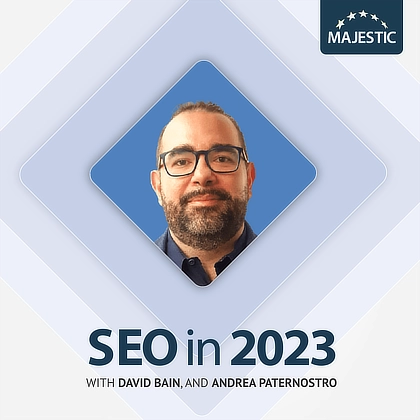-
Site Explorer
- Majestic
- Resumo
- Domínios de Ref
- Backlinks
 Novo
Novo Perdido
Perdido- Contexto
- Texto Âncora
- Páginas
- Tópicos
- Link Graph
- Sites relacionados
- Ferramentas Avançadas
- Author ExplorerBeta
- Summary
- Profile Backlinks
- Attributions
- Comparar
-
Ferramentas de Links
- Meu Majestic
- Atividade Recente
- Relatórios
- Campanhas
- Domínios Verificados
- OpenApps
- Chaves de API
- Palavras-chave
- Gerador de Palavra-chave
- Keyword Checker
- Search Explorer
- Ferramentas de Links
- Backlinks em Massa
- Verificador de Vizinhança
- Enviar URLs
- Majestic Million
- Experimental
- Fusão de Índice
- Disputa de Link Profile
- Links Recíprocos
- Solo Links
- Relatório em pdf
- Typo Domain
- Suporte
Perform a content consolidation audit
Andrea Paternostro
Andrea Paternostro has a four-step process that will help SEOs in 2023 to consolidate their content and strike a balance between freshness and intelligently reclaiming existing content.

Perform a content consolidation audit
Andrea says: “My tip is to perform a content consolidation audit. If you think of the word ‘CoCoA’, it’s easy to remember. We should strike a balance between the freshness of our content and the need for consolidation - the intelligent reuse of existing content.”
I know that you’ve got a four-step process. What is step number one?
“My first step is to avoid low page quality. We should mention Google’s Quality Raters Guidelines, which is a document that is very important for us. Dan Tayler wrote about this last July on Search Engine Land. He went deep into this process and the need to look at the Google Search Console and see what prevents some pages from being indexed.
It’s good that not everything is going to be indexed – as not everything we publish has value - but we should try to have some pages that have a high value proposition and concentrate our efforts on taking care of these pages. Another negative consequence of low page quality is cannibalization. We might be aiming at the same keyword rankings on Google with different pages, but only one is good for our revenues.”
What is step number two?
“Number two is to make intelligent use of existing content. In a survey, Orbit Media found that bloggers who update all their posts are three times more likely to get a result. Updating posts and reusing content is so important for driving better organic results on Google. Sometimes we don’t need to create new content. Why not concentrate on what we already have?
There are a lot of ways to do that: third-party tools, Search Console, etc. I live in two different realities. Irion, which is a B2B software company, and Milano Weekend, which is a B2C daily newspaper about events and leisure. Different customer journeys, different complexities, and different SEO goals.
At Irion, what’s important is lead generation - as a marketing team and for branding. We need to communicate the expertise, authoritativeness, and trustworthiness of the company (the famous acronym ‘EAT’) supporting a very complex customer journey. Sometimes, we merge all three pieces of content into only one. In regulatory reporting, for example - which is a complex topic about regulations, laws, and what banks should do for compliance.
Our business goal is lead generation and not traffic. We don’t have to look at the traffic. We may sacrifice some page views in order to drive better leads. Instead, we look at the long-tail model and see what opportunities there are for ranking in the long-tail.
At Milano Weekend, on the other hand, we aim for traffic. We need more traffic, and we need more domain authority to appear in SEO tools and to drive our sales. For a lot of companies all around Europe and the world, their SEO agencies are writing to us and ordering a guest post, for example. You can only be good at selling guest posts if you have good domain authority, and your rankings are good. That’s a very different context and objective.”
How do you know it’s the right time to start updating your content?
“You can set up various tools for lifting data about your SEO rankings, but I think you need an expert eye in your team that can strike a balance with the possibility of writing new content. It depends on your company. Do you need to hire another writer or can you write something by yourself or with your collaborators? It depends on the organisation.
Usually, the more often you can update your posts, the better. In the publishing business, for example, an exhibition, an event, or a concert might come to the same city year after year, and you might use the same URL. You don’t need to change the URL, just write the new content straight into the page.
For a B2B business, on the other hand, evergreen content is so important. When you’re looking at regulatory reporting or another complex topic - like data management, data quality, or data governance - things don’t change as often. You don’t need to make many contributions, so you don’t need to look at reports every week. You need to fulfil the business’s needs. For some topics, you may give a monthly look at ranking reports, for other topics that may be every three months. It depends on the business.
Align with the business and talk to your top management, then you will know when it’s time to prioritise a content operation because your company needs to sell a product at that specific moment.”
How do you know which articles to merge together?
“It’s good practice to make some templates. For blockbuster and product pages, we have two templates at Irion. All the content produced five or six years ago might have a different template. While you are porting the old content into the new template, you will discover more things to do.
You’ll discover that you can reword the title, you can add a description, and you can add a fresh image to rank in Google Images - and this happens a lot for complex topics and business topics. Google Images is so powerful for being discovered.
You can do a lot of content operations by just getting started. Open your CMS and start doing things. You will discover many things that can be made better in your content.”
What is step number three?
“Number three is to ensure the alignment between business metrics and content strategy. This is something that we need to learn as marketing teams: we need to speak the language of the business. Sometimes we talk about content KPI, pageviews, service validation, etc., and top management doesn’t care at all. Top management just wants to know about revenue and sales: ‘How has updating my content contributed to better sales?’.
I can show that some of the leads that have been made in my company in the last 18 months have visited our website. In their complex customer journey (their ‘messy middle’ as Google calls it) they had a touchpoint with our website once, twice, three times. What has our website communicated to them? Expertise, authoritativeness, and trustworthiness. The three things that today’s Google wants in order to rank you in competitive markets.”
What is step number four?
“Go deep into Search Console analysis, because there are some things in the coverage report that can explain why some pages are not correctly indexing.
You can look at the duplicate pages, for example, or the soft 404 - which often comes out in the Google Search Console notifications. For some soft 404s, if they are useful, you may choose to manage them with a 301 redirect or you may choose to go canonical, because there may be a problem with categorization. If it’s not useful, I usually go with a 404, but I know some people prefer the 410 HTTP code. It depends. When Google comes into a website and crawls, it is often able to understand that 404 pages should not be taken into consideration anymore.
It depends on the user experience. Some websites find a good result with the use of 404 and some find better results with the other codes. The only way to find out which is the best situation for your website is to test a lot and understand that a resource can only be useful or not useful for the user.”
Would you ensure that each page that you want to rank can be found and crawled by search engines?
“Yes. Not only found and crawled but, if we really want that page to be indexed, we need to focus on the reasons why it may not have been indexed yet. We should push for manual indexing through Search Console if we need that page to be indexed.
Sometimes the guest post pages asked for by our clients absolutely need to be indexed, because some clients want to appear in Google News as soon as possible. They value our website, and our publications, because they are included in Google News. Sometimes you need to give the Googlebot a shake. Often, you get a good result from a manual push.”
What shouldn’t SEOs be doing in 2023? What’s seductive in terms of time, but ultimately counterproductive?
“Being too frenetic about the changes and fluctuations in your Google rankings can be very bad for your mental health, and for the overall outcome of the project. Have weekly notifications via email for your rankings, if not monthly.
Google is changing too fast, the search engine results pages are changing too fast, and there are too many fluctuations. We should not worry because it’s not a good thing to concentrate too much on the quantity of fluctuations.
When we communicate with our clients or stakeholders, whether we are an agency or we are in a company, we don’t need to take these fluctuations to our top manager every week or every month, because they don’t need this information. They just need to know if the content operations have led to more sales or not.”
Should SEOs set up an alert, so that if their rankings fall below certain parameters, then they can go and check them?
“Yes, we should set up the correct alerts for our business needs. Today, SEO reports are too thick, too long, and done too often. We should communicate better with our clients and our top management, and we need to have the courage to communicate concisely - to say just a few things. Focus on business metrics and leave out the technical part that they don’t want to listen to.”
Andrea Paternostro is a Technical SEO and Content Strategy Trainer, and you can find him over at andreapaternostro.com.
Choose Your Own Learning Style
 Video
Video
If you like to get up-close with your favourite SEO experts, these one-to-one interviews might just be for you.
Watch all of our episodes, FREE, on our dedicated SEO in 2023 playlist.
 Podcast
Podcast
Maybe you are more of a listener than a watcher, or prefer to learn while you commute.
SEO in 2023 is available now via all the usual podcast platforms
Don't miss out
Opt-in to receive email updates.
It's the fastest way to find out more about SEO in 2024.
Nós podemos melhorar essa página para você? Conte pra gente






